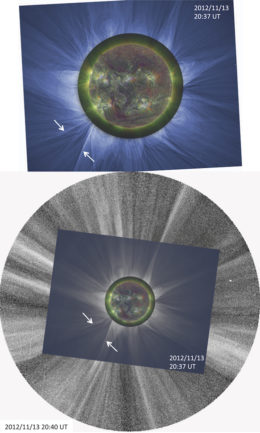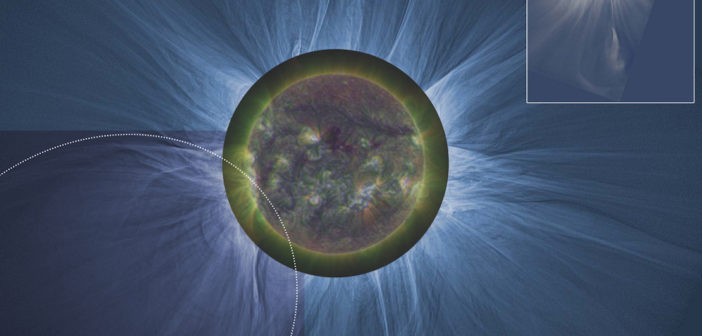
Images taken during the solar eclipse in 2012. The central color composite of the eclipsed solar surface was captured by SDO, the white-light view of the solar corona around it was taken by the authors, and the background, wide-field black-and-white view is from LASCO. The white arrows mark the “atypical” structure. [Alzate et al. 2017]
The answer is yes — plenty! Illustrating this point, a new study using such equipment recently reports on the structure and dynamics of the Sun’s corona during two solar eclipses.
A Full View of the Corona
The solar corona is the upper part of the Sun’s atmosphere, extending millions of kilometers into space. This plasma is dynamic, with changing structures that arise in response to activity on the Sun’s surface — such as enormous ejections of energy known as coronal mass ejections (CMEs). Studying the corona is therefore important for understanding what drives its structure and how energy is released from the Sun.
Though there exist a number of space-based telescopes that observe the Sun’s corona, they often have limited fields of view. The Solar Dynamics Observatory AIA, for instance, has spectacular resolution but only images out to 1/3 of a solar radius above the Sun’s limb. The space-based coronagraph LASCO C2, on the other hand, provides a broad view of the outer regions of the corona, but it only images down to 2.2 solar radii above the Sun’s limb. Piecing together observations from these telescopes therefore leaves a gap that prevents a full picture of the large-scale corona and how it connects to activity at the solar surface.
To provide this broad, continuous picture, a team of scientists used digital cameras mounted on ~10-cm telescopes to capture white-light images from the solar surface out to several solar radii using a natural coronagraph: a solar eclipse. The team made two sets of observations: one during an eclipse in 2012 in Australia, and one during an eclipse in 2013 in Gabon, Africa. In a recent publication led by Nathalia Alzate (Honolulu Community College), the team now reports what they learned from these observations.Building Atypical Structures
The authors’ image processing revealed two “atypical” large-scale structures with sharp edges, somewhat similar in appearance to what is seen near the boundaries of rapidly expanding polar coronal holes. But these structures, visible in the southeast quadrant of the images taken during both eclipses, were not located near the poles.
By analyzing their images along with space-based images taken at the same time, Alzate and collaborators were able to determine that the shape the structures took was instead a direct consequence of a series of sudden brightenings due to low-level flaring events on the solar surface. These events were followed by small jets, and then very faint, puff-like CMEs that might otherwise have gone unnoticed.

Impact of the passage of a series of puff-like CMEs (shown in the LASCO time sequence in the bottom panels) on coronal structures. [Alzate et al. 2017]
Citation
Nathalia Alzate et al 2017 ApJ 848 84. doi:10.3847/1538-4357/aa8cd2


2 Comments
Pingback: Little Eyes on Large Solar Motions – MeasurementDataBases for Industry & Science
Pingback: Observando los grandes movimientos solares con ojos pequeños. – Asociación de Aficionados a la Astronomía del Uruguay